‘Her Majesty for this quarrell is to sustayn a greater warr than ever in any memory of man it hath done’

'Her Majesty for this quarrell is to sustayn a greater warr than ever in any memory of man it hath done'
By Richard Bishop
Three extremely fine silver medals, recently acquired by Spink, illustrate with great force and originality the decade or more of constant warfare that was the dominant feature of the closing years of the long reigns of both Elizabeth of England and Philip of Spain. They also provide an opportunity to consider other aspects of life in the rebellious Dutch Provinces in that Protestant corner of Europe that seemed to be fighting for its very survival against the mighty Spanish, for though the medals deal ostensibly with the war between England and Spain, they were not struck in England, but in the Netherlands.
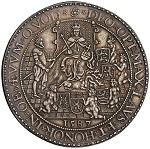 |
The first medal, dated 1587, shows us Elizabeth enthroned, her feet on a seven headed monster. At her right stands Robert Dudley, Earl of Leicester, the Queen's favourite. He treads on the monster's tail and seizes the Queen's robe imploringly. He is interceding for the Dutch Provinces, Gelre (or Guelderland), Holland, Zeeland, Utrecht and Friesland. These Provinces are represented by five small boys who kneel before the Queen. The date of the medal tells us that this is not a plea for Elizabeth to accept the role of Protector or even Sovereign, of the Dutch Provinces, for by 1587 she had already accepted such a role. This is propaganda.
The Hydra that Elizabeth tramples is of course to be interpreted as the many headed monster that is made up of the Papacy, the Kingdom of Spain, the Holy Roman Empire, the Duke of Guise, and other Catholic princes who supported their cause. The use of the image in this particular way has a long history. Martin Luther became convinced that the Pope was the Anti-Christ in 1520 and in 1522 he is depicted by Hans Holbein as Hercules Germanicos, the Hydra of Popery at his feet. Henry of Navarre, while leader of the Protestant cause in France, was frequently depicted as Hercules. Even as king he is depicted as Hercules, battling against his numerous enemies, principally the Spanish. He slays the Hydra on a column designed for his entry to Lyons in 1595, and a few years later in a painting from the studio of Toussaint Dubreuil, now in the Louvre, he tramples on a dead Hydra. The French audience knew as well as did the Germans exactly what the Hydra represented, 'c'est-à-dire la Ligue'. In giving aid to the rebellious Provinces, Elizabeth is making war on Spain, and so she tramples the Catholic Hydra underfoot, and Leicester, her Lieutenant in the Netherlands, stands on its tail.
But the Hydra has a wider significance to the 16th century viewer. It is a symbol of discord and is frequently used as a symbol of rebellion against lawful authority. The 'mob' was always the many headed monster throughout the medieval period and, as Shakespeare frequently reminds us, in late 16th century England this view had not changed. So placing the Hydra beneath the feet of the Queen, who for some time had been reluctant to openly assist the Dutch in their struggle against their legally recognised master, must here be very deliberate.
Elizabeth no longer had qualms about assisting the Dutch. This was in stark contrast to her attitude just a few years earlier. The open revolt by the Dutch Provinces had been a reality for some years before the Act of Abjuration, taken by ten of the Provinces in 1581, formally proclaimed to the world that Philip had forsaken his flock and the throne was therefore vacant. At that time Elizabeth would have no part in the rebellion, and she consistently refused all requests for assistance, as well as refusing the offer of Sovereignty from some of the Provinces. In fact the Provinces were forced to turn elsewhere, and they tried a number of other leaders, with generally unsatisfactory results. But by 1585 Elizabeth felt her hand being forced. The formation of the Catholic League at the Treaty of Joinville in December 1584, an alliance between the French Catholics, led by the powerful Duke of Guise, and the Spanish, greatly alarmed the Queen. Protestant England was clearly the intended target for this Catholic League. It was clear that war with Spain was inevitable, no matter what happened in the Netherlands.
And so it was that, in August 1585, Elizabeth signed the treaty of Nonsuch with the United Provinces, accepting the title Protector, and promising the rebels money and men. Lord Burghley predicted a great war, and the Queen herself was certainly under no illusions. She addressed the Dutch negotiators at Nonsuch in these words; 'Messieurs, vous voyez astheure que jay ouverte le porte et que je m'embarque de tout pour vous en une guerre contre le roy d'Espaigne. Eh bien! Je ne m'en donne pas de peine.'
The legend around this scene is, at first glance, unremarkable. 'DEO. OPT. MAX. LAVS. ET. HONOR. IN. OE. AVVM. QVOD.'. Some of the words are abbreviated but the meaning is easy, 'To the best and greatest God, be praise and glory forever.' The scene is reminiscent of an apocalyptic vision, a monarch enthroned, a many headed monster being subdued, supplicants around the throne, and a hymn of praise to God. But the legend ends in a curious way with the word QVOD. Why should the legend end so enigmatically with the Latin word for 'because…'? Some commentators have suggested that no more of the phrase could be included but the meaning was still clear to the 16th century audience. This will not do. Firstly there are words that have been abbreviated so that this final word can be included. Secondly, the shout of praise in the Book of Revelation that this legend echoes continues '… you are worthy of glory and honour because you made all the universe…' Such a message does not chime with the rest of the message of the medal. The engraver however wanted his audience to ask themselves what more was to come, and then turn the medal over. There is much more to come.
Given the very specific nature of the obverse, the reverse of this medal is remarkable. We move from a scene that refers to a real political situation to a scene of Apocalyptic destruction. Our feeling that the obverse was reminiscent of a scene from the Book of Revelation might be justified.
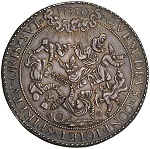 |
The Pope, Bishops, and other ecclesiastics, are flung in confusion from the heavens. The Hebrew name of Jehovah appears above, leaving us in no doubt that these men are being expelled from the presence of God. The legend reinforces this. QVEM. DEVS. CONFICIET. SPIRITV. ORIS. SVI., 'whom the Lord shall consume with the spirit of his mouth.'
Now this legend, like that on the obverse, has been very carefully chosen. The quotation is from Saint Paul's second letter to the Thessalonians. In this letter Paul discusses in great detail a subject that was taxing the early Church in Thessalonika, and which was taxing the minds of all Protestant Reformers at the end of the 16th century, the subject of the imminent Second Coming of Christ. Paul expressed his thoughts in terms of contemporary apocalyptic writing. The whole phrase sounds most portentous in the King James translation, 'And then shall that Wicked be revealed, whom the Lord shall consume with the Spirit of His Mouth and shall destroy with the Brightness of His Coming.' The phrase 'the Brightness of His Coming' is a translation of the Latin 'illustri adventu suo', and the word 'adventu' is in turn a translation of the Greek 'epiphaneia', which can also be translated as 'revelation.'
The message of the medal has suddenly deepened. This is not just a struggle of the Protestant states against their overbearing Spanish masters, nor the clash of the Kingdoms of England and Spain. This is no less than the beginning of the Final Battle, the End of Things, the fight against the Anti-Christ. Such thoughts were never far from the minds of men in these times, as numerous tracts, histories, sermons, poems, and pamphlets testify. The greatest poem of the age, Spencer's Faerie Queene, is patterned on the Apocalypse of Saint John. As men looked towards the approaching end of the century such thoughts loomed large. The dramatic overthrow of the Anti-Christ and all his army of wicked followers provided the anonymous artist of this medal with a wonderful subject, and he has taken advantage of it to the full.
The second medal in our group refers to the events of just one year later. At the end of April 1588 intelligence reports from France warned the servants of the English Queen (and now the Protector of the seven United Provinces) of the exact scale of the imminent danger. Philip of Spain was sending forth his great Armada, 130 vessels, with man power amounting to 7,070 Spanish soldiers, 2,000 Portuguese soldiers, 137 'commoners', 160 'adventurers', 8,050 mariners, 160 boys, 238 gentlemen, 130 gentlemen's servants, 85 doctors, surgeons and apothecaries, 104 priests, friars and monks with 50 servants, and, most ominous of all, 90 hangmen and executioners. The result of the expedition is well known. This medal celebrates the dispersal of this great fleet and the destruction of many of the ships. But as with the first medal, the artist has more to say than this.
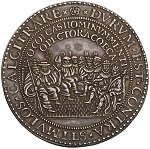 |
The reverse shows us the destruction of the fleet with the legend VENI VIDE VIVE 'come, see, live,' a mocking allusion to Caesar's boast of 'Veni, Vidi, Vinci'. The legend around reads TV. DEVS. MAGNVS. ET. MAGNA. FACIS. TV. SOLVS. DEVS., 'Thou, God, art great and doest great things. Thou art God alone.' So far so good, and only to be expected on a medal celebrating such an event.
The obverse however is quite another story, and its remarkable depiction and legends has made it one of the most famous medals of the period.
The Pope, the King of Spain, the Emperor, the Duke of Guise, and all the usual suspects, are gathered as if in a consistory of the Catholic super powers. They are all seated. But they are all blindfolded, and spikes are pressing up through the floor to prick their heels. Around them we read the legend DVRVM. EST. CONTRA, STIMVLOS. CALCITRARE., 'It is hard to kick against the pricks', and above them another legend O. COECAS. HOMINVM. MENTES. O PECTORA. COECA.. 'oh! blind minds of men, oh! blind hearts.' The image and the combination of legends have no precedent, and they need some unravelling.
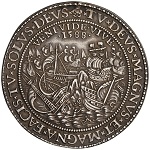 |
First, we have 'to kick against the pricks'. This is a curious phrase, a popular saying that can be found in most of the compilations of phrases and proverbs that were so common in the 16th century. The illustrations that accompany this saying usually show a man dressed as a fool kicking uselessly against an object or an obstruction. The origin of the phrase is to be found in the universal practice of training and controlling domesticated animals by use of a pointed stick or goad. A young, untrained animal would naturally kick out against such a goad, but an experienced beast would allow itself to be guided by it. In a Christian context the moral is obvious. Only a fool, or a wicked man, would continue to resist divine guidance.
Used in the context of this medal the phrase is even more pertinent, for the medallist (for reasons that will become apparent), is clearly using the phrase as spoken by Saint Paul in the Acts of the Apostles. In chapter 26 of Acts, Paul, who has fallen foul of the local Jewish authorities, is summoned to appear before King Agrippa and give an account of himself. He briefly relates to Agrippa the story of his early life, and then he describes in detail his conversion on the road to Damascus. At the point when he is struck down, Paul tells the king that he heard a voice saying 'Saul, Saul, why do you persecute me? It is hard for you to kick against the goad.' The saying is not to be found in the original description of the event, but only in Paul's retelling of it. Paul has been struck blind, has had his sight restored, and is now a much wiser man. He now knows it is useless to resist the Divine Will.
The saying is therefore the perfect one to put around a depiction of the Pope and his allies, sitting together, uselessly kicking against spikes beneath their feet. The Elizabethan audience would have enjoyed this medal greatly. And if the scriptural reference was not enough for them, there was that other very popular notion in late 16th century thinking, the ' prick of conscience' that we all have, and that we ignore at our peril.
Second, we have 'Oh blind minds of men, oh blind hearts'. This is taken from Book 2 of Lucretius 'De Rerum Natura.' The book opens with the famous passage, inspired no doubt by the teachings of Epicurus, in which Lucretius describes how the wise man does not involve himself in the trouble and strife of this world, but holds himself aloof. How sweet it is to look down from a safe vantage point at the floods and tempests, at the battling armies and toiling workers. 'There is nothing more goodly than to hold the high serene plateaus, well fortressed by the wise, whence thou mayst look below on other men and see them everywhere wand'ring, all dispersed, in their lone seeking for the road of life, rivals in genius, or emulous of rank, pressing through days and nights with endless toil, seeking summits of power and mastery of the world. Oh wretched minds of men, oh blind hearts.'
At first Lucretius might seem an odd choice here. His epic poem on the Nature of Things is hardly a tract in favour of faithful religious observance. In fact it is just the opposite. The brilliance and originality of the poetry however was enough to earn Lucretius his place in the library of every educated scholar. His influence in the early years of the Renaissance in Italy was profound, as a brief time contemplating Botticelli's Primavera always reminds us. And he talks of matters that were of great interest to the scholars and thinkers of the age, such as the mutability of things, whether events happened by chance and at random, or according to some higher unseen power, whether nature was influenced by certain forces, or was uncontrolled and uncontrollable. He is quoted frequently, and frequently the context is surprising. Here we have him telling us that the foolish men depicted on this medal are not only immune to the lessons of Scripture, but with all their learning they cannot even hear the wisdom of the ancient philosophers.
The medallist is cramming in as many messages as he can within the small compass of one medal. He has the foolish company all blindfolded, and with this simple device he brings in a wealth of ideas. The blind man wanders everywhere through Mediaeval and Renaissance art. He appears in paintings, in plays and in interludes, he is described in sermons, and of course he features in those popular books of proverbs and sayings. He is often a beggar, or a pilgrim, he wears torn clothing, sometimes he carries a hurdy-gurdy, and he is usually led by another, a small boy or less often a woman, who walks ahead, the blind man's hand resting on their shoulder. He is a lost soul. He stumbles easily and so crossing a narrow bridge is particularly dangerous. But what if blind men lead other blind men? What if the blind man cannot cross the narrow bridge, the symbolic way from this world to the next, because the main bridge builder, the Pontifex Maximus himself, is blind? A popular miracle story with the Reformers was that of the man who was born blind, for he is cured by his faith alone. Martin Luther, contemplating misguided human nature, observed that sometimes a man becomes 'so evil that he neither thanks nor worships. Rather he blinds his own eyes and so falls continually into wickedness.' And this is the point of the blindfolds. These men are not born blind, they have chosen to be blind and they have put on their own blindfolds. The loose ties clearly fly out behind their heads. They will not listen to the Divine Word, nor to the enlightened teaching of Reformers, and they cannot help each other, for how can the blind lead the blind?
And so this second medal takes us once again from contemplating a contemporary event on one side, to a meditation on deeper aspects of human nature on the other, and not surprisingly, these are aspects that were of particular concern at the time.
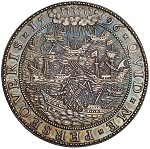 |
The last of our three medals was struck in 1596, almost at the end of the century, and after many years of conflict. The danger from Spain was if anything even greater than it had been in 1588. From these later years there has survived far more literature on war, more books dealing with the morality of warfare and the concept of a just war, more pamphlets describing how to resist the Spanish armies, or how to avoid them altogether, and more sermons preaching comfort in times of distress, than we have from the days of the first Armada in 1588.
Once again the occasion for the medal is the destruction of a Spanish fleet, this time by a storm off Cape Finisterre, and the design is very similar to the previous medal. Once again we have ships in distress, with a Spanish galley again prominent in the centre. Either the engraver has not developed his ideas at all during the intervening period, or another artist has merely followed a tried and tested formula. But this time we have the Hebrew word Jehovah above the fleet. This was purely a Divine act, and man played no part in the destruction of this, the last of the great Spanish Armadas.
The legend here however is once again of interest, for it is QVID. ME. PERSEQVERIS., 'why do you persecute me?' This is of course the question put to Paul on the road to Damascus, and it confirms that the saying on the previous medal was indeed taken from the Acts of the Apostles.
But the other side of this medal does not give us a meditation on human nature, nor does it deal with matters of universal concern. Instead we are presented with a simple depiction of the shields of England and France and a heart with the arrows of the United Provinces, all united by a cord held by a hand from heaven. The legend RVMPITER. HAVD. FACILE. tells us that this alliance was 'not easily broken.' This alludes to the alliance formed between England, France and the United Provinces against the Spanish.
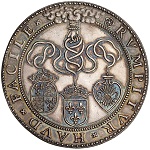 |
The artist should have chosen a less political and ephemeral subject for his medal, for the alliance that should be 'not easily broken' was indeed almost immediately broken. Henry IV of France had already shown his Protestant allies that religious beliefs should not stand in the way of political success when he experienced his sudden 'conversion' to Catholicism in 1593. Now, as the Catholic King of France, he made a show of unity with his former allies, but in fact he quickly and secretly concluded a separate peace with the Spanish. Territorial ambition, the king was now free to attack his other neighbour, the Duke of Savoy, and the needs of his own subjects, who were crying out for peace, are put before all religious considerations.
The century draws to a close with nothing resolved, and all is in that state of flux that so fascinated writers of the period. France would continue to wage religious war against itself. Henry IV would be assassinated. The remaining Protestant allies, England and the United Provinces, would soon be arguing over fishing rights in home waters and trading rights in foreign lands. In London, in 1600, John Norden, a prolific writer and sermoniser, published his 'Vicissitudo Rerum, an Elegiacall Poem, on the Interchangeable Courses and Variety of Things in this World.' It was a best seller. 'O miseras hominum mentes, o pectora caeca!'



